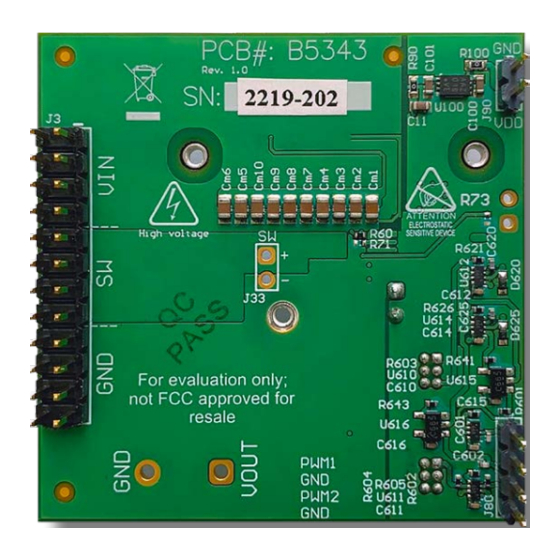EPC EPC90147 Skrócona instrukcja obsługi - Strona 5
Przeglądaj online lub pobierz pdf Skrócona instrukcja obsługi dla Płyta główna EPC EPC90147. EPC EPC90147 14 stron.

QUICK START GUIDE
Boost Converter configuration
Warning: Never operate the boost converter mode without a
load, as the output voltage can increase beyond the maximum
ratings.
To operate the board as a boost converter, either a single or dual
PWM inputs can be chosen using the appropriate jumper settings
on J630 (mode).
To select Single Input Boost Mode, the bypass jumper J640 must
be set to the no-bypass mode, the boost mode J630 must be
selected as shown in figure.7(a).
To select Dual Input Boost Mode, the bypass jumper J640 may be
configured to any of the valid settings, the dual-input mode J630
must be selected as shown in figure 7(b).
Note: It is important to provide the correct PWM signals that
includes dead-time and polarity when operating in bypass mode.
Once the input source, dead-time settings and bypass configura-
tions have be chosen and set, then the boards can be operated.
1. The inductor (L1) and input capacitors (labeled as Cout) can
either be soldered onto the board, as shown in figure 7, or
provided off board. Anti-parallel diodes can also be installed
using the additional pads on the right side of the EPC23102 FETs.
2. With power off, connect the input power supply bus to V
and ground / return to GND, or externally across the capacitor
if the inductor L1 and Cout are provided externally. Connect the
output voltage
(labeled as
resistive load.
3. With power off, connect the gate drive supply to V
and ground return to GND (J1, Pin-2 indicated on the bottom
side of the board).
4. With power off, connect the input PWM control signal to PWM1
and/or PWM2 according to the input mode setting chosen and
ground return to any of GND J2 pins indicated on the bottom
side of the board.
5. Turn on the gate drive supply – make sure the supply is between
7.5 V and 12 V.
6. Turn on the controller / PWM input source.
7.
Making sure the output is not open
supply voltage is initially 0 V, turn on the power and slowly
increase the voltage to the required value
the absolute maximum
switching operation.
8. Once operational, adjust the PWM control, bus voltage, and load
within the operating range and observe the output switching
behavior, efficiency, and other parameters. Observe device
temperature for operational limits.
9. For shutdown, please follow steps in reverse.
EPC – POWER CONVERSION TECHNOLOGY LEADER |
VIN) to your circuit as required, e.g.,
(J1, Pin-1)
DD
circuit, and the input
(do not exceed
voltage). Probe switch-node to see
EPC-CO.COM
| ©2022 |
Optional anti-
12 V
DC
parallel diodes
V
supply
DD
(Note polarity)
Must be in
No-bypass
position
+
PWM1
(default)
Jumper positions for
single-input boost
Optional anti-
OUT
12 V
DC
parallel diodes
V
supply
DD
(Note polarity)
All valid
positions
permitted
PWM1
+
Upper
FET
PWM2
+
Lower
FET
Jumper positions for
dual-input boost
Figure 7: (a) Single-PWM input boost converter (b) Dual-PWM input boost
converter configurations showing the supply, inductor, anti-parallel diodes, input
capacitor, PWM, and load connections with corresponding jumper settings.
EPC90147
Input Capacitor
Boost Inductor
V
supply
Main
(Note polarity)
(a)
Input Capacitor
Boost Inductor
V
supply
Main
(Note polarity)
(b)
DC load
80 V
DCmax
DC load
80 V
DCmax
| 5
